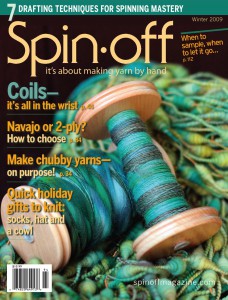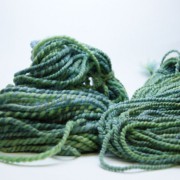PLY like an eagle
Spinzilla invited me to be part of their 2015 blog tour. I was assigned the topic of plying and if there’s anything I know, it’s plying. I’ve plied even, I’ve plied off-tensioned, I’ve plied with a push up and a squiggle, I’ve plied the same yarn this way and that way and over and over. I used to devote one workday a week to experimental plying. Once I plied a yarn 6 times, just to see what would happen.
- Experiments in plying
- experiments in plying
- just because I could
- seeing how fine I can ply
- supercoil plying
Yep, it’s no secret that I’ve made my career off of plying, from the beginning to now and into the foreseeable future. My first years selling yarn, teaching and writing were based on plying. Man alive did I love spinning coils. It’s all I wanted to do for a while. Did I ever tell you how I learned? It was way back before etsy and ravelry. People were still using LJ (live journal) and I happened upon a photo of a yarn by Adrian Bazilia. I’d been spinning straight and sturdy yarn for 2 years and here was this poppy, fun yarn that sung to my spinning soul. I e-mailed her and asked her how she accomplished such a feat. She (gracefully, for I was a complete stranger asking her to write a tutorial for me when she’d rather be spinning, canning, and dying fiber) sent me a quick run down of the steps needed to coil .*
 The first 5 years of my spinning career was all about plying. I supported a family of 3 and then 4 with what Esther Rodgers now calls “wild-plied yarns” but what I called “textured spinning” in an attempt to escape the moniker “art yarn”. I spun 6 hours a day 5 days a week and we scraped by. I mean, seriously scraped by. Of course, Sit and Spin came and went and then articles for Spin Off (and my first cover!). Thank goodness for Spin Off! I really feel like it was due to that long-running magazine that current-day textured spinning got legitimatized in the eyes of the larger spinning community. And then Spin Art. All the while, my adventures with plying stayed the course.
The first 5 years of my spinning career was all about plying. I supported a family of 3 and then 4 with what Esther Rodgers now calls “wild-plied yarns” but what I called “textured spinning” in an attempt to escape the moniker “art yarn”. I spun 6 hours a day 5 days a week and we scraped by. I mean, seriously scraped by. Of course, Sit and Spin came and went and then articles for Spin Off (and my first cover!). Thank goodness for Spin Off! I really feel like it was due to that long-running magazine that current-day textured spinning got legitimatized in the eyes of the larger spinning community. And then Spin Art. All the while, my adventures with plying stayed the course.
For me, for a long while, plying was about texture and balance. I was really concerned with balance. I remember telling the Yarn Harlot once, on a shuttle to Madrona, that I felt like everything I spun must be balanced. She asked me why I hated singles so much and I replied that it wasn’t that I hated singles, it’s that I felt like the yarns I was spinning, teaching, basing my career on, were assumed by many to be novelty, unbalance-able, unworkable, and to be taken seriously I needed to show everyone that everything that came off my wheel could hang perfectly straight and was never tension-set. She told me that was silly. She also told me that wearing a sweater the first hour of class until everyone realized I was nice before I took it off and revealed my tattoo-covered arms, was silly too.
She was right on both accounts.
Just like it took me years to find comfort in spinning longdraw, it took me a long time to understand the subtlety of plying. Back before the Yarn Harlot took me to task for not giving fiber people enough credit, both as spinners and as people, I didn’t realize that different yarns required different plying (outside of textured techniques, of course). I was long into spinning before I knew very much. Here’s a few things I’ve picked up about plying:
Yarn shouldn’t come off bobbin hanging straight and limp. I used to feel such a swell of pride taking my yarn off my bobbin seeing no twist in the skein. Limp and flaccid, bah. That’s not how we want our yarns! Give it some life! Let that baby have a bit more twist. You want it coming off the bobbin with a twist or 2 in the skein. It’ll balance out in the end but you’ll have a yarn that feels and looks better, a yarn that says “I’m alive!!
Woolen and worsted yarns don’t’ get the same amount of ply twist. It’s true. A woolen yarn’s structure is in the PLY, that’s what really holds that light and fluffy thing together. It’s what gives it strength and the ability to ward off the dreaded pill. It needs more ply-twist than singles-twist. For reals. Worsted yarn, on the other hand, has it’s structure in the single and it wants less ply-twist, relatively speaking. Truth.
The tighter the ply, the better the wear (not the tighter that single, that way lies rope, my friends).
 Oh my, this one took seeing my sweet Olive wearing a handspun, handknit sweater to really sink in. Spun out of the softest merino but with lots of singles-twist for (I thought) better wear and then a balancing amount of ply-twist, it was lovely to look at. To look at. When had her put the jacket on, baby, did we both have a surprise! A surprising amount of strength was necessary to get her arms down by her side. I pushed them down and they popped right back up! Look how she has to hold on to the body of the sweater to keep her arms down! I managed to get a couple of shots off before she shed the thick, stiff sweater complaining of ickiness.
Oh my, this one took seeing my sweet Olive wearing a handspun, handknit sweater to really sink in. Spun out of the softest merino but with lots of singles-twist for (I thought) better wear and then a balancing amount of ply-twist, it was lovely to look at. To look at. When had her put the jacket on, baby, did we both have a surprise! A surprising amount of strength was necessary to get her arms down by her side. I pushed them down and they popped right back up! Look how she has to hold on to the body of the sweater to keep her arms down! I managed to get a couple of shots off before she shed the thick, stiff sweater complaining of ickiness.
Remember when I said it doesn’t always have to be perfectly balanced? if current-jacey-spinner could talk to past-jacey-spinner this is what I’d say – dude, don’t increase your single- twist, increase your ply-twist or your going to have to store that sweater, unworn for the rest of your life and when you die, it’ll get passed down and down and everyone will wonder how you ever ran a spinning magazine because it’ll be the only example of your spinning left since nobody ever wore or touched the sweater more than once, and that, past-jacey-spinner, is not the example of your spinning you want standing the test of time. Also, it’s okay to take off your sweater, especially if it’s hot, they don’t mind.
These two yarns, for instance, are the same fiber, the same dye-job, the same ypp! The only difference is that the one on the right has lots of singles-twist and is plied to balance and the one on the left has smaller amount of singles-twist but the same amount of ply-twist as the other! That’s right, the ply-twist amounts are the same. If you could feel these yarns, one would make you swoon while the other would make you avert your eyes and secretly wonder how I manage to fill any class, spinning cord-y yarn like that!
The more plies in a yarn, the less ply-twist it takes to reach balance (I knew this before Patsy Z’s illuminating article, but just barely). Math is cool, right?
So don’t think I hate singles yarns. I love singles yarns! I just love plying too. Theoretically, you could say that singles yarns are about the individual and Plying is about the team. It’s part of the reason I named the magazine PLY. PLYing is about texture and balance and strength and bringing different things together so they can lean and benefit and support. And if, in 10 years time, I wrote another post about plying, I’m sure the things I will have learned since now will be far more than I’ve learned so far. That’s the way of spinning, the more you learn, the father you have to go, and we wouldn’t have it any other way, right?
Spinzilla is a global event where teams and individuals compete in a friendly challenge to see who can spin the most yarn in a week! Spinzilla team registration is open until September 22. The Ply team is full, but there are plenty of teams that still need you! There will be prizes! Click here to register. One hundred percent of your registration fee will go to the NeedleArts Mentoring Program. For more information, see their FAQ page.
* Huh, I’ve never put that together before. The first time I asked a stranger to share their spinning know-how with me, she did. Just like that. I asked, she told. Must have sunk in on some level I didn’t realize because that’s what I’ve been doing ever since. Silly me to have never seen that, thanks, Adrian!









Just registered for Spinzilla in the Hill Country Weavers team, and very excited! I’m looking forward to a fun week!
yay! It’s going to be such a blast! Good luck! and when your fingers start to bleed a bit, just push through!
Very helpful and understandable. Glad I read this before I plied my woolen singles waiting for me. P.S. I’m glad you bare arms in your ‘head shots’ nowadays… the tats inspired me to scope out your magazine & subscribe… before I even knew you were a legit spinner. Lol.
Ha! I like to think of myself as barely legit!
Lots of interesting things here – thank you for putting what overwhelms me at times in a fun way that inspires me to do much more with my spinning too. Am really enjoying Ply Magazines here in the UK. Happy Spinning!
Spinning should be fun! Good luck!
all good stuff!
For knitters.
But what if you are weaving with the yarn…… ? 🙂
you’re right!
Looks like I need to take up another craft!